Inverse Kinematic Solver Based on Bat Algorithm for Robotic Arm Path Planning
Abstract
1. Introduction
2. Related Works
3. Inverse Kinematics Problem
4. Proposed Method
4.1. Bat Algorithm
- Position : corresponds to the position of the bat in the search space, representing a candidate solution of the optimization problem.
- Velocity : is the velocity of the bat, which models an incremental variation of the position between 2 successive iterations.
- Frequency : is the frequency of the emitted pulse. It is used to adjust the velocity change.
- Loudness : represents the loudness of the emitted pulse. It enables a local search around the best solution.
- Pulse rate : is the rate of the emitted pulses. It increases gradually along the iterations of the algorithm, assuming a consistent gradual compromise from an exploration phase to an exploitation phase.
| Algorithm 1: Pseudo code of BA |
| Input: Fitness function: , Number of bats: , Maximum number of iterations: , frequency range: and , increasing coefficient: , Attenuation coefficient: |
| Output: Best solution |
| Initialize the bat population and ; |
| Define pulse frequency at ; |
| Initialize pulse rates and the loudness ; |
| while do |
| for do |
| Adjust frequency using Equation (5); |
| Update velocity and position using Equations (6) and (7), respectively; |
| if then // rand is a random number in [0, 1] |
| Select a solution among the best solutions ; |
| Generate a local solution around the selected best solution using Equation (8); |
| End |
| evaluate the new solution according to the objective; |
| if then |
| Accept the new solution; |
| Increase and decrease using Equations (9) and (10); |
| End |
| Rank the bats according to their fitness and update the best solution ; |
| End |
| End |
4.2. Bat Algorithm for Inverse Kinematics
| Algorithm 2: IK-BA pseudo code |
| Input: IK fitness function: , Number of bats: Maximum number of iterations: , frequency range: and , increasing coefficient: , Attenuation coefficient: , Initial configuration: , Target position: |
| Output: Best solution |
| Initialize the bat population and ; |
| Define pulse frequency at ; |
| Initialize pulse rates and the loudness ; |
| while do |
| Increase and decrease using Equations (9) and (10); |
| for do |
| Adjust frequency using Equation (5); |
| Update velocity depending on using Equation (13) and the position and using Equation (7); |
| Select a solution among the best solutions |
| Generate a local solution around the selected best solution depending on using Equation (14); |
| evaluate the new solution according to the fitness function fit(X) and target position |
| if then |
| Accept the new solution; |
| end |
| Rank the bats according to their fitness and update the best solution ; |
| end |
| end |
4.3. IK-BA for Decoupled Position-Orientation
5. Simulation Results
5.1. Kinematic Modeling of the KUKA LBR Iiwa 14 R820
- : indicates a rotational transformation from frame to frame around the axis, therefore is the angle between and through .
- : indicates a displacement from frame to frame along the axis, it is measured as the distance from to along the
- : indicates a displacement from frame to frame along the new axis, therefore it represents the distance between and axes along .
- : indicates a rotational movement from frame to the frame around the new axis, therefore is the angle between from to axes about the axis.
5.2. Path Tracking Test
- Source: stands for source of variation, which could be a variation between groups (algorithms’ sample results), or error variation, indicating a variation within the groups.
- SS: stands for sums of squares.
- df: degrees of freedom, which indicates the number of independent data.
- MS: mean squares, they are calculated by dividing sums of squares (SS) by their appropriate degrees of freedom.
- F: refers to the F-statistic, which used to test the null hypothesis that the means of several groups are equal. It is calculated as the ratio of the variation between the groups to the variation within the groups.
- Prop > F: indicates the p-value which is used to determine the level of significance of the F-statistic and helps to decide whether the null hypothesis of equal means is rejected or not.
5.3. Time Assessment
5.3.1. Time Assessment of the IK-BA for Real-Time Path Planning
5.3.2. Discussion on Time Processing of MH Inverse Solvers
6. Real Application
7. Conclusions
Author Contributions
Funding
Data Availability Statement
Conflicts of Interest
References
- Yim, M.; Shen, W.; Salemi, B.; Rus, D.; Moll, M.; Lipson, H.; Klavins, E.; Chirikjian, G.S. Modular Self-Reconfigurable Robot Systems [Grand Challenges of Robotics]. IEEE Robot. Autom. Mag. 2007, 14, 43–52. [Google Scholar] [CrossRef]
- Wallén, J. The History of the Industrial Robot; Linköping University Electronic Press: Linköping, Sweden, 2008. [Google Scholar]
- Olofsson, B.; Nielsen, L. Path-Tracking Velocity Control for Robot Manipulators with Actuator Constraints. Mechatronics 2017, 45, 82–99. [Google Scholar] [CrossRef]
- Antonelli, G.; Chiaverini, S.; Fusco, G. An Algorithm for Online Inverse Kinematics with Path Tracking Capability under Velocity and Acceleration Constraints. In Proceedings of the 39th IEEE Conference on Decision and Control (Cat. No.00CH37187), Sydney, NSW, Australia, 12–15 December 2000; Volume 5, pp. 5079–5084. [Google Scholar]
- Denavit, J.; Hartenberg, R.S. A Kinematic Notation for Lower-Pair Mechanisms Based on Matrices. J. Appl. Mech. 1955, 22, 215–221. [Google Scholar] [CrossRef]
- Kucuk, S.; Bingul, Z. Robot Kinematics: Forward and Inverse Kinematics; IntechOpen: Rijeka, Croatia, 2006; ISBN 9783866112858. [Google Scholar]
- Bingul, Z.; Ertunc, H.M.; Oysu, C. Applying Neural Network to Inverse Kinematic Problem for 6R Robot Manipulator with Offset Wrist. In Proceedings of the Adaptive and Natural Computing Algorithms, Coimbra, Portugal, 21–23 March 2005; Ribeiro, B., Albrecht, R.F., Dobnikar, A., Pearson, D.W., Steele, N.C., Eds.; Springer: Vienna, Austria, 2005; pp. 112–115. [Google Scholar]
- Secară, C.; Vlădăreanu, L. Iterative Genetic Algorithm Based Strategy for Obstacles Avoidance of a Redundant Manipulator. In Proceedings of the 2010 American Conference on Applied Mathematics, Cambridge, MA, USA, 27–29 January 2010; World Scientific and Engineering Academy and Society (WSEAS): Stevens Point, WI, USA, 2010; pp. 361–366. [Google Scholar]
- Oulhadj, H.; Daachi, B.; Menasri, R. Metaheuristics for Robotics; John Wiley & Sons: Hoboken, NJ, USA, 2020; ISBN 9781786303806. [Google Scholar]
- El-Sherbiny, A.; Elhosseini, M.A.; Haikal, A.Y. A Comparative Study of Soft Computing Methods to Solve Inverse Kinematics Problem. Ain Shams Eng. J. 2018, 9, 2535–2548. [Google Scholar] [CrossRef]
- Waldron, K.J.; Schmiedeler, J. Kinematics. In Springer Handbook of Robotics; Siciliano, B., Khatib, O., Eds.; Springer Handbooks; Springer International Publishing: Cham, Switzerland, 2016; pp. 11–36. ISBN 9783319325521. [Google Scholar]
- Köker, R.; Öz, C.; Çakar, T.; Ekiz, H. A Study of Neural Network Based Inverse Kinematics Solution for a Three-Joint Robot. Robot. Auton. Syst. 2004, 49, 227–234. [Google Scholar] [CrossRef]
- Guo, J.; Cherkassky, V. Cherkassky A Solution to the Inverse Kinematic Problem in Robotics Using Neural Network Processing. In Proceedings of the International 1989 Joint Conference on Neural Networks, Washington, DC, USA, 18–22 June 1989; Volume 2, pp. 299–304. [Google Scholar]
- Cursi, F.; Bai, W.; Yeatman, E.M.; Kormushev, P. Task Accuracy Enhancement for a Surgical Macro-Micro Manipulator with Probabilistic Neural Networks and Uncertainty Minimization. IEEE Trans. Autom. Sci. Eng. 2022, 1–16. [Google Scholar] [CrossRef]
- Wichapong, K.; Bureerat, S.; Pholdee, N. Solving Inverse Kinematics of Robot Manipulators by Means of Meta-Heuristic Optimisation. IOP Conf. Ser. Mater. Sci. Eng. 2018, 370, 012056. [Google Scholar] [CrossRef]
- Abdel-Basset, M.; Abdel-Fatah, L.; Sangaiah, A.K. Chapter 10—Metaheuristic Algorithms: A Comprehensive Review. In Computational Intelligence for Multimedia Big Data on the Cloud with Engineering Applications; Sangaiah, A.K., Sheng, M., Zhang, Z., Eds.; Intelligent Data-Centric Systems; Academic Press: Cambridge, MA, USA, 2018; pp. 185–231. ISBN 9780128133149. [Google Scholar]
- Tian, Z.; Fong, S. Survey of Meta-Heuristic Algorithms for Deep Learning Training; IntechOpen: Rijeka, Croatia, 2016; ISBN 9789535125938. [Google Scholar]
- Ahuactzin, J.M.; Gupta, K.K. The Kinematic Roadmap: A Motion Planning Based Global Approach for Inverse Kinematics of Redundant Robots. IEEE Trans. Robot. Autom. 1999, 15, 653–669. [Google Scholar] [CrossRef]
- Jones, D.R.; Schonlau, M.; Welch, W.J. Efficient Global Optimization of Expensive Black-Box Functions. J. Glob. Optim. 1998, 13, 455–492. [Google Scholar] [CrossRef]
- Cursi, F.; Bai, W.; Yeatman, E.M.; Kormushev, P. GlobDesOpt: A Global Optimization Framework for Optimal Robot Manipulator Design. IEEE Access 2022, 10, 5012–5023. [Google Scholar] [CrossRef]
- Craig, J.J. Introduction to Robotics: Mechanics and Control; Pearson Educación: London, UK, 2005; ISBN 9789702607724. [Google Scholar]
- Spong, M.W.; Hutchinson, S.; Vidyasagar, M. Robot Modeling and Control, 1st ed.; Wiley: Hoboken, NJ, USA, 2005; ISBN 9780471649908. [Google Scholar]
- Abdor-Sierra, J.A.; Merchán-Cruz, E.A.; Rodríguez-Cañizo, R.G. A Comparative Analysis of Metaheuristic Algorithms for Solving the Inverse Kinematics of Robot Manipulators. Results Eng. 2022, 16, 100597. [Google Scholar] [CrossRef]
- Holland, J.H. Adaptation in Natural and Artificial Systems: An Introductory Analysis with Applications to Biology, Control and Artificial Intelligence; MIT Press: Cambridge, MA, USA, 1992; ISBN 9780262581110. [Google Scholar]
- Goldberg, D.E.; Holland, J.H. Genetic Algorithms and Machine Learning. Mach. Learn. 1988, 3, 95–99. [Google Scholar] [CrossRef]
- Parker, J.K.; Khoogar, A.R.; Goldberg, D.E. Inverse Kinematics of Redundant Robots Using Genetic Algorithms. In 1989 IEEE International Conference on Robotics and Automation; IEEE Computer Society: Washington, DC, USA, 1989; pp. 271–276. [Google Scholar]
- Nearchou, A.C. Solving the Inverse Kinematics Problem of Redundant Robots Operating in Complex Environments via a Modified Genetic Algorithm. Mech. Mach. Theory 1998, 33, 273–292. [Google Scholar] [CrossRef]
- Tarokh, M.; Zhang, X. An Adaptive Genetic Algorithm for Real-Time Robotic Trajectory Tracking. IFAC Proc. Vol. 2006, 39, 199–204. [Google Scholar] [CrossRef]
- Yang, X.-S. Chapter 14—Multi-Objective Optimization. In Nature-Inspired Optimization Algorithms; Yang, X.-S., Ed.; Elsevier: Oxford, UK, 2014; pp. 197–211. ISBN 9780124167438. [Google Scholar]
- Kennedy, J.; Eberhart, R. Particle Swarm Optimization. In Proceedings of the ICNN’95—International Conference on Neural Networks, Perth, WA, Australia, 27 November–1 December 1995; Volume 4, pp. 1942–1948. [Google Scholar]
- Rokbani, N.; Alimi, A.M. Inverse Kinematics Using Particle Swarm Optimization: A Statistical Analysis. Procedia Eng. 2013, 64, 1602–1611. [Google Scholar] [CrossRef]
- Huang, H.-C.; Chen, C.-P.; Wang, P.-R. Particle Swarm Optimization for Solving the Inverse Kinematics of 7-DOF Robotic Manipulators. In Proceedings of the 2012 IEEE International Conference on Systems, Man, and Cybernetics (SMC), Seoul, Republic of Korea, 14–17 October 2012; pp. 3105–3110. [Google Scholar]
- Rokbani, N.; Slim, M.; Alimi, A.M. The Beta Distributed PSO, β-PSO, with Application to Inverse Kinematics. In Proceedings of the 2021 National Computing Colleges Conference (NCCC), Taif, Saudi Arabia, 27–28 March 2021; pp. 1–6. [Google Scholar]
- Adly, M.A.; Abd-El-Hafiz, S. Inverse Kinematics Using Single- and Multi-Objective Particle Swarm Optimization. In Proceedings of the 2016 28th International Conference on Microelectronics (ICM), Giza, Italy, 17–20 December 2016. [Google Scholar] [CrossRef]
- Tripathi, P.K.; Bandyopadhyay, S.; Pal, S.K. Multi-Objective Particle Swarm Optimization with Time Variant Inertia and Acceleration Coefficients. Inf. Sci. 2007, 177, 5033–5049. [Google Scholar] [CrossRef]
- Rokbani, N.; Neji, B.; Slim, M.; Mirjalili, S.; Ghandour, R. A Multi-Objective Modified PSO for Inverse Kinematics of a 5-DOF Robotic Arm. Appl. Sci. 2022, 12, 7091. [Google Scholar] [CrossRef]
- Bayati, M. Using Cuckoo Optimization Algorithm and Imperialist Competitive Algorithm to Solve Inverse Kinematics Problem for Numerical Control of Robotic Manipulators. Proc. Inst. Mech. Eng. Part I J. Syst. Control. Eng. 2015, 229, 375–387. [Google Scholar] [CrossRef]
- El-Sherbiny, A.; Elhosseini, M.A.; Haikal, A.Y. A New ABC Variant for Solving Inverse Kinematics Problem in 5 DOF Robot Arm. Appl. Soft Comput. 2018, 73, 24–38. [Google Scholar] [CrossRef]
- Zhang, L.; Xiao, N. A Novel Artificial Bee Colony Algorithm for Inverse Kinematics Calculation of 7-DOF Serial Manipulators. Soft Comput. 2019, 23, 3269–3277. [Google Scholar] [CrossRef]
- Rokbani, N.; Casals, A.; Alimi, A.M. IK-FA, a New Heuristic Inverse Kinematics Solver Using Firefly Algorithm. In Computational Intelligence Applications in Modeling and Control; Azar, A.T., Vaidyanathan, S., Eds.; Studies in Computational Intelligence; Springer International Publishing: Cham, Switzerland, 2015; pp. 369–395. ISBN 9783319110172. [Google Scholar]
- Dereli, S.; Köker, R. Calculation of the Inverse Kinematics Solution of the 7-DOF Redundant Robot Manipulator by the Firefly Algorithm and Statistical Analysis of the Results in Terms of Speed and Accuracy. Inverse Probl. Sci. Eng. 2020, 28, 601–613. [Google Scholar] [CrossRef]
- Rokbani, N.; Mirjalili, S.; Slim, M.; Alimi, A.M. A Beta Salp Swarm Algorithm Meta-Heuristic for Inverse Kinematics and Optimization. Appl. Intell. 2022, 52, 10493–10518. [Google Scholar] [CrossRef]
- Lopez-Franco, C.; Diaz, D.; Hernandez-Barragan, J.; Arana-Daniel, N.; Lopez-Franco, M. A Metaheuristic Optimization Approach for Trajectory Tracking of Robot Manipulators. Mathematics 2022, 10, 1051. [Google Scholar] [CrossRef]
- Kanagaraj, G.; Masthan, S.S.; Yu, V.F. Meta-Heuristics Based Inverse Kinematics of Robot Manipulator’s Path Tracking Capability Under Joint Limits. Mendel 2022, 28, 41–54. [Google Scholar] [CrossRef]
- Lopez-Franco, C.; Hernandez-Barragan, J.; Alanis, A.Y.; Arana-Daniel, N. A Soft Computing Approach for Inverse Kinematics of Robot Manipulators. Eng. Appl. Artif. Intell. 2018, 74, 104–120. [Google Scholar] [CrossRef]
- Yang, X.-S. A New Metaheuristic Bat-Inspired Algorithm. In Nature Inspired Cooperative Strategies for Optimization (NICSO 2010); González, J.R., Pelta, D.A., Cruz, C., Terrazas, G., Krasnogor, N., Eds.; Studies in Computational Intelligence; Springer: Berlin/Heidelberg, Germany, 2010; pp. 65–74. ISBN 9783642125386. [Google Scholar]
- Yang, X.-S. Chapter 10—Bat Algorithms. In Nature-Inspired Optimization Algorithms; Yang, X.-S., Ed.; Elsevier: Oxford, UK, 2014; pp. 141–154. ISBN 9780124167438. [Google Scholar]
- Gupta, A. BAT Optimization Algorithm. Available online: https://www.mathworks.com/matlabcentral/fileexchange/68981-bat-optimization-algorithm (accessed on 31 August 2022).
- Martínez-Cagigal, V. Multi-Objective Particle Swarm Optimization (MOPSO)—File Exchange—MATLAB Central. Available online: https://www.mathworks.com/matlabcentral/fileexchange/62074-multi-objective-particle-swarm-optimization-mopso (accessed on 17 September 2022).
- Chiaverini, S.; Oriolo, G.; Walker, I.D. Kinematically Redundant Manipulators. In Springer Handbook of Robotics; Siciliano, B., Khatib, O., Eds.; Springer: Berlin/Heidelberg, Germany, 2008; pp. 245–268. ISBN 9783540303015. [Google Scholar]
- Sawilowsky, S.S. Nonparametric Tests of Interaction in Experimental Design. Rev. Educ. Res. 1990, 60, 91–126. [Google Scholar] [CrossRef]
- Arora, J.S. Chapter 17—Nature-Inspired Search Methods. In Introduction to Optimum Design, 4th ed.; Arora, J.S., Ed.; Academic Press: Boston, MA, USA, 2017; pp. 739–769. ISBN 9780128008065. [Google Scholar]
- Liu, J.W.S. Real-Time Systems, 1st ed.; Prentice Hall: Upper Saddle River, NJ, USA, 2000; ISBN 9780130996510. [Google Scholar]
- Laplante, P.A. Real-Time Systems Design and Analysis: Laplante/Real-Time Systems Design; John Wiley & Sons, Inc.: Hoboken, NJ, USA, 2004; ISBN 9780471648291. [Google Scholar]
- Nguyen, H. Design of Laser Engraving Environment for Dobot Magician. Bachelor’s Thesis, Häme University of Applied Sciences, Hämeenlinna, Finland, 2022. [Google Scholar]
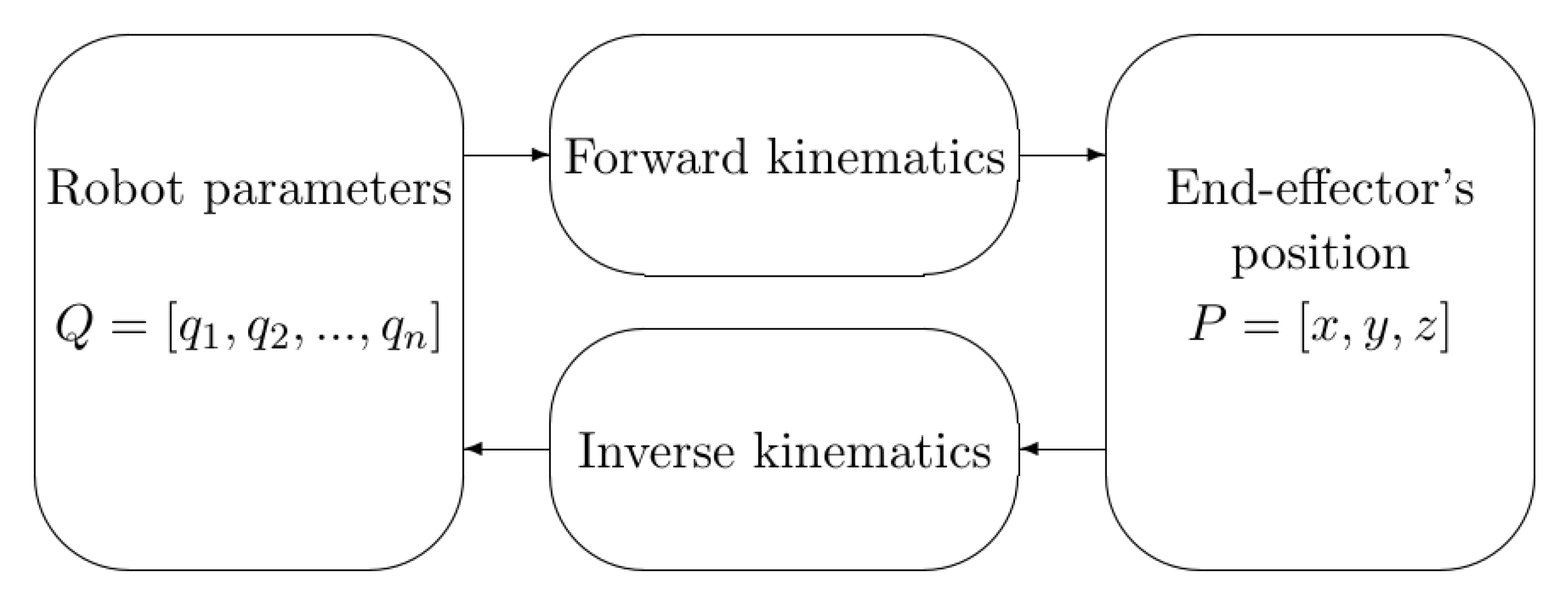

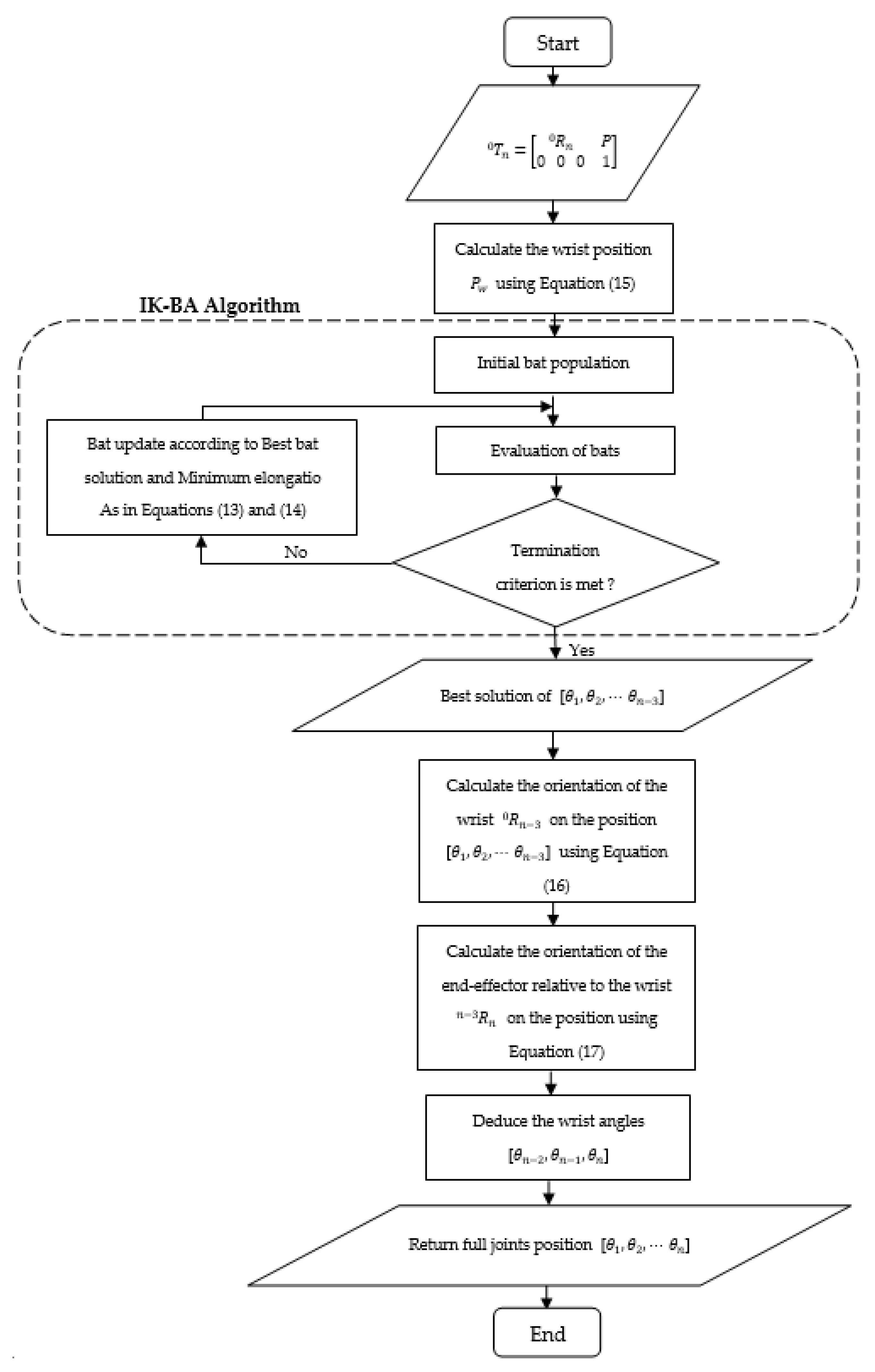


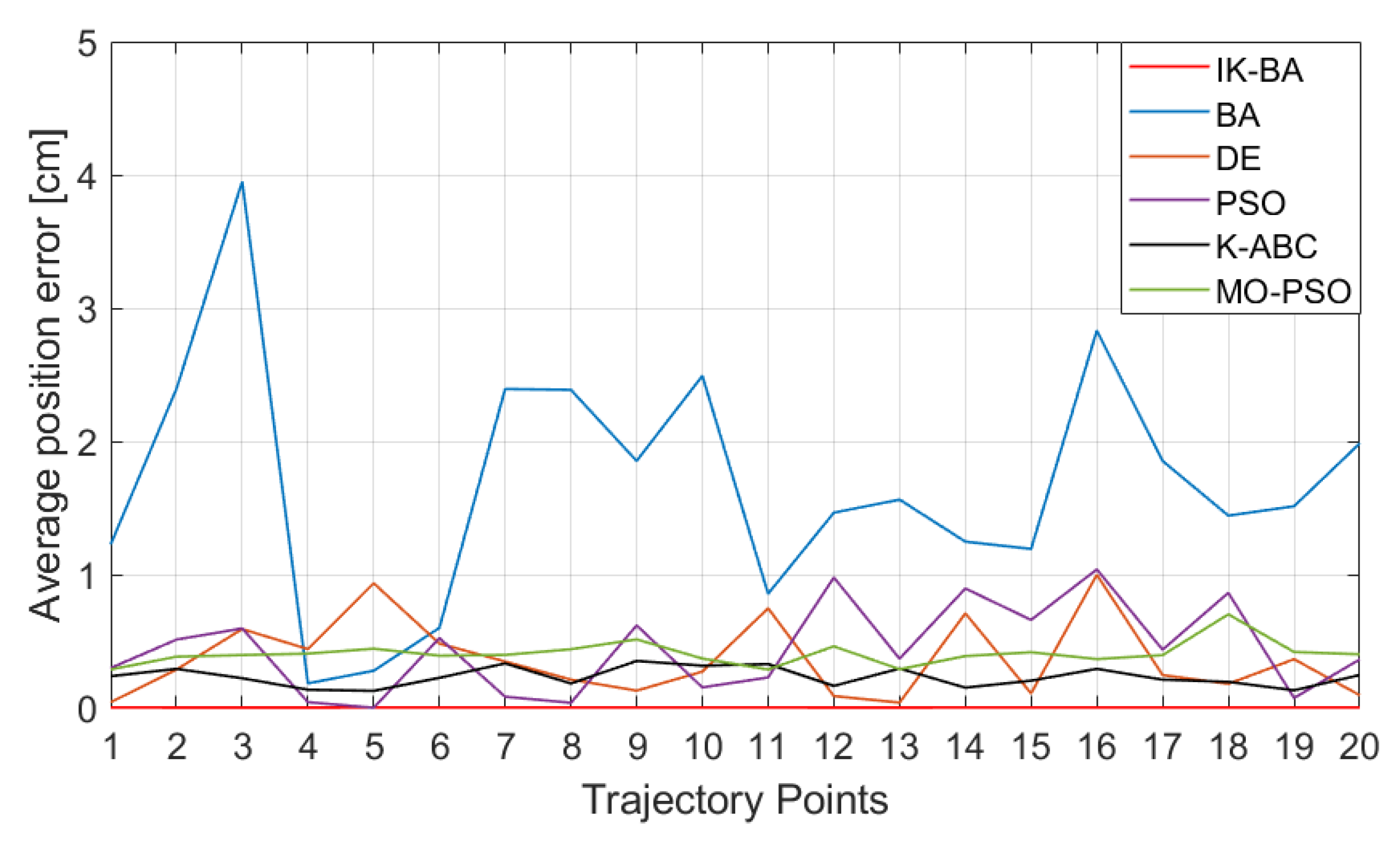
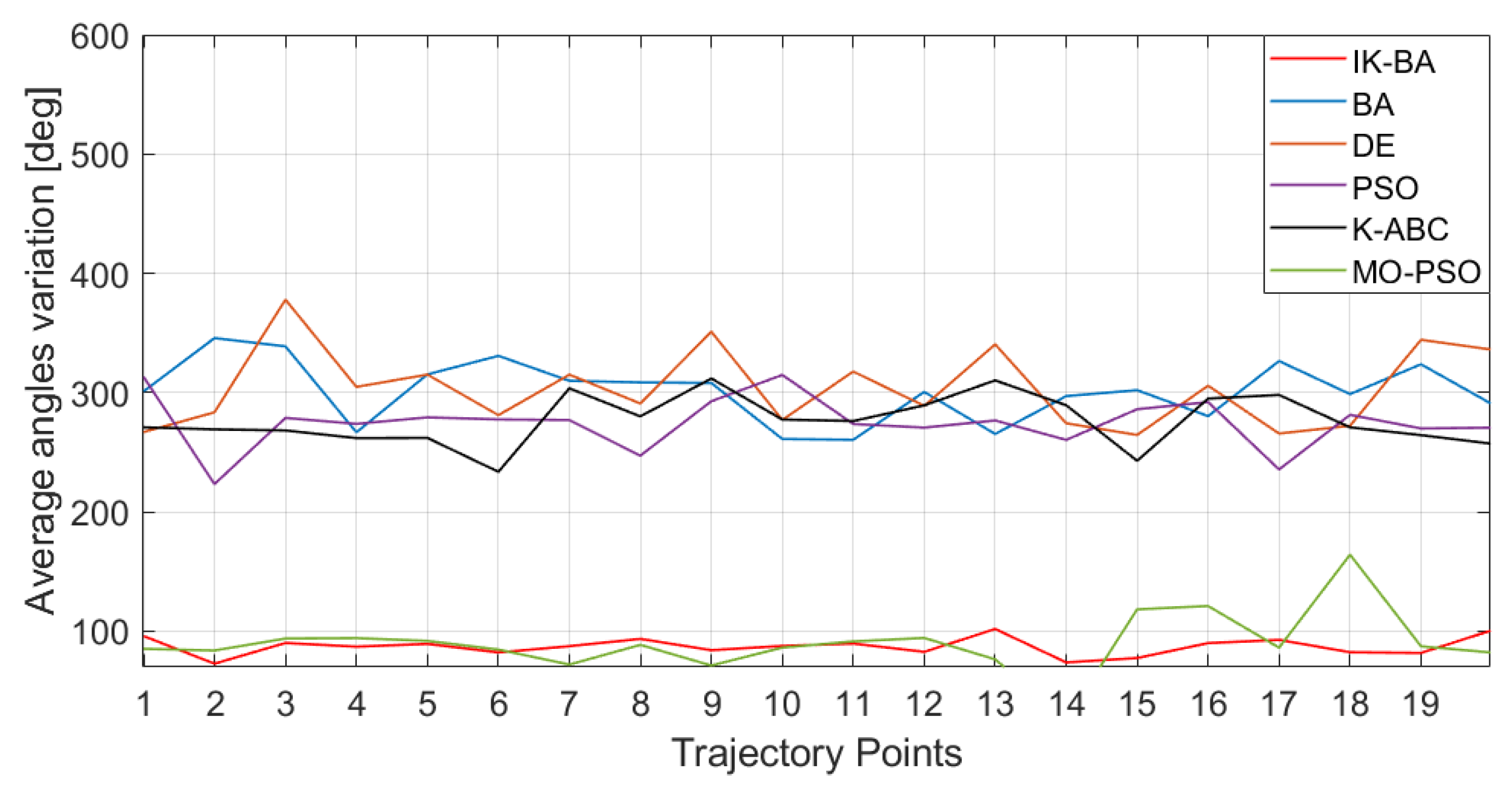


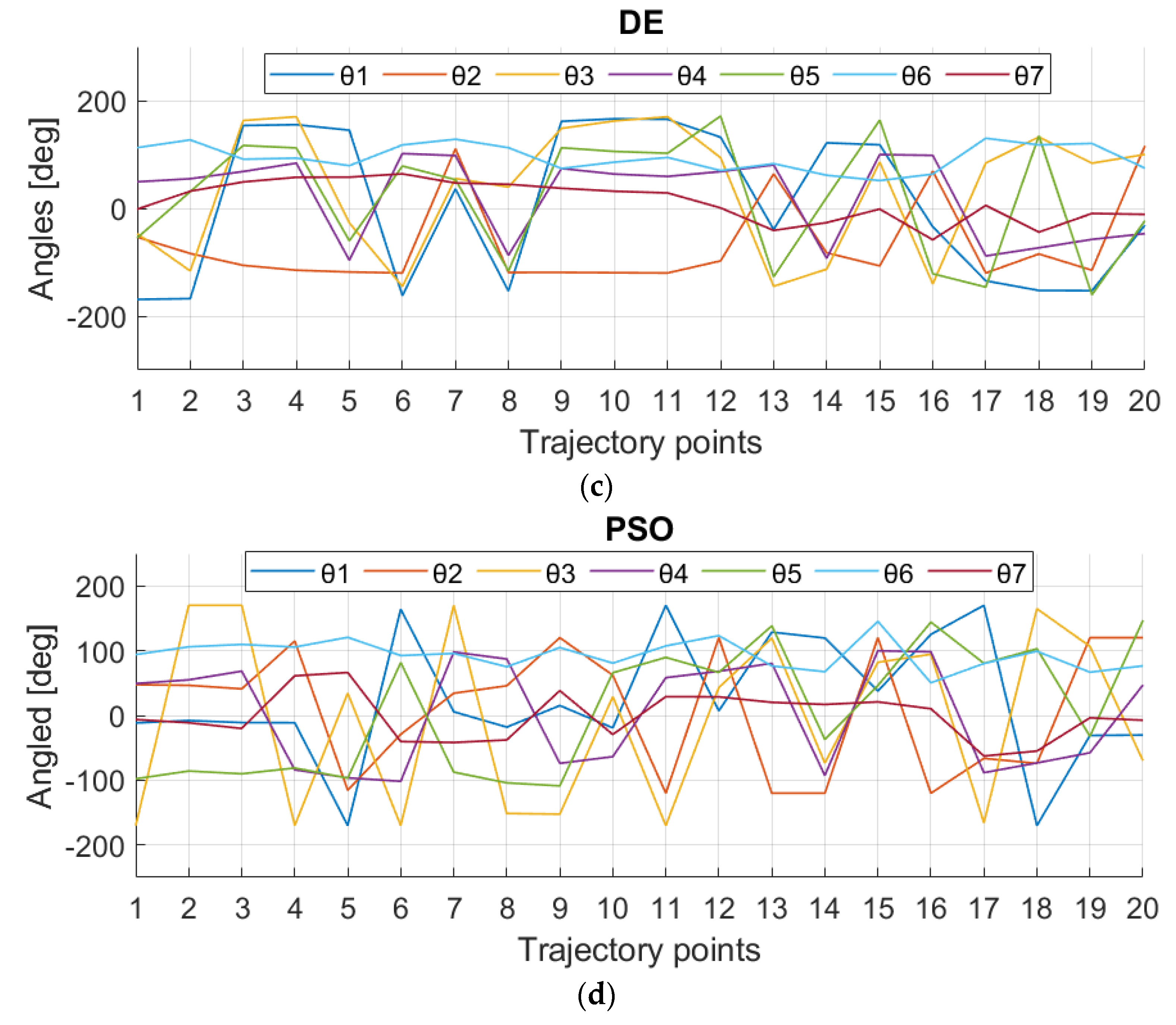

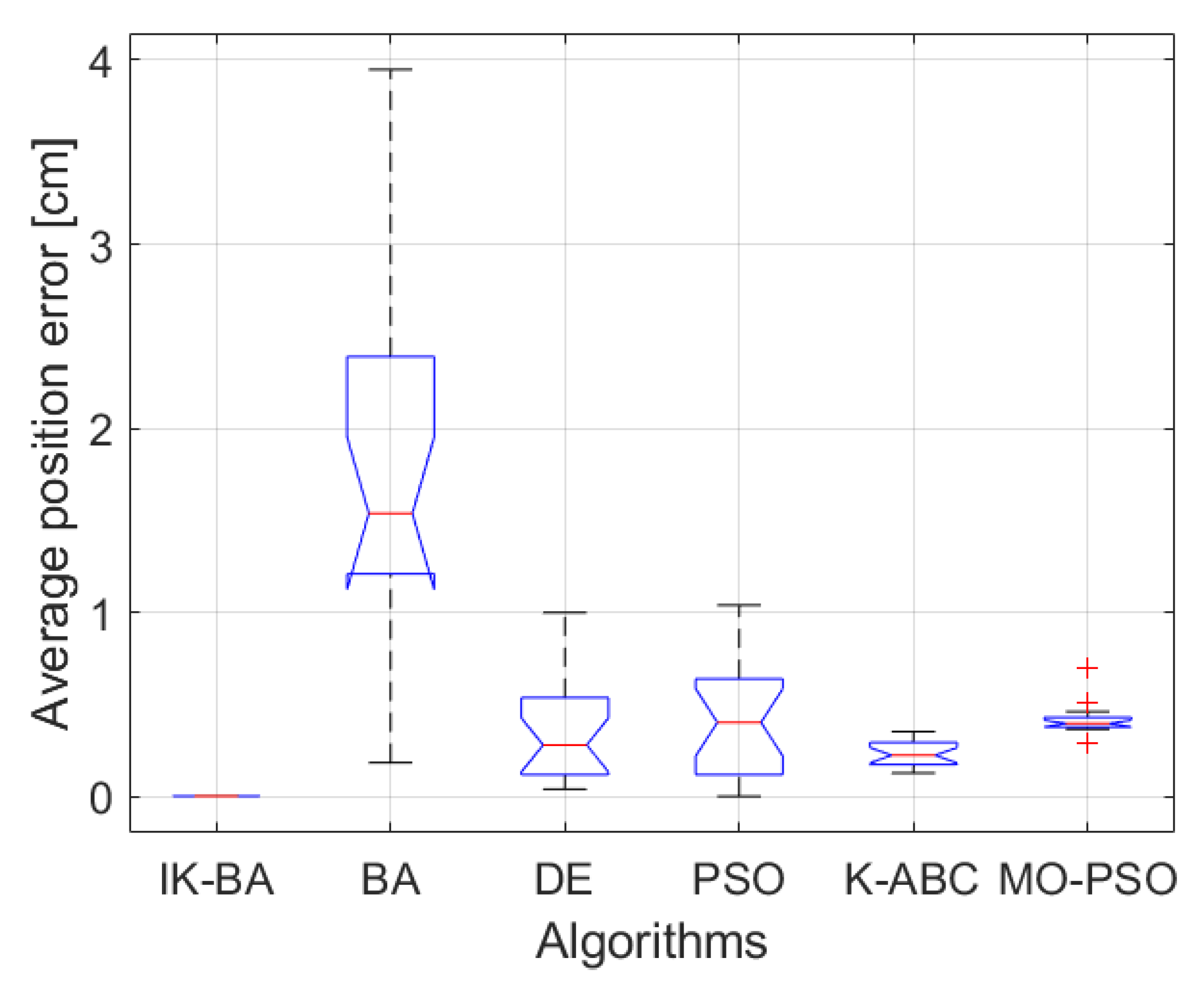
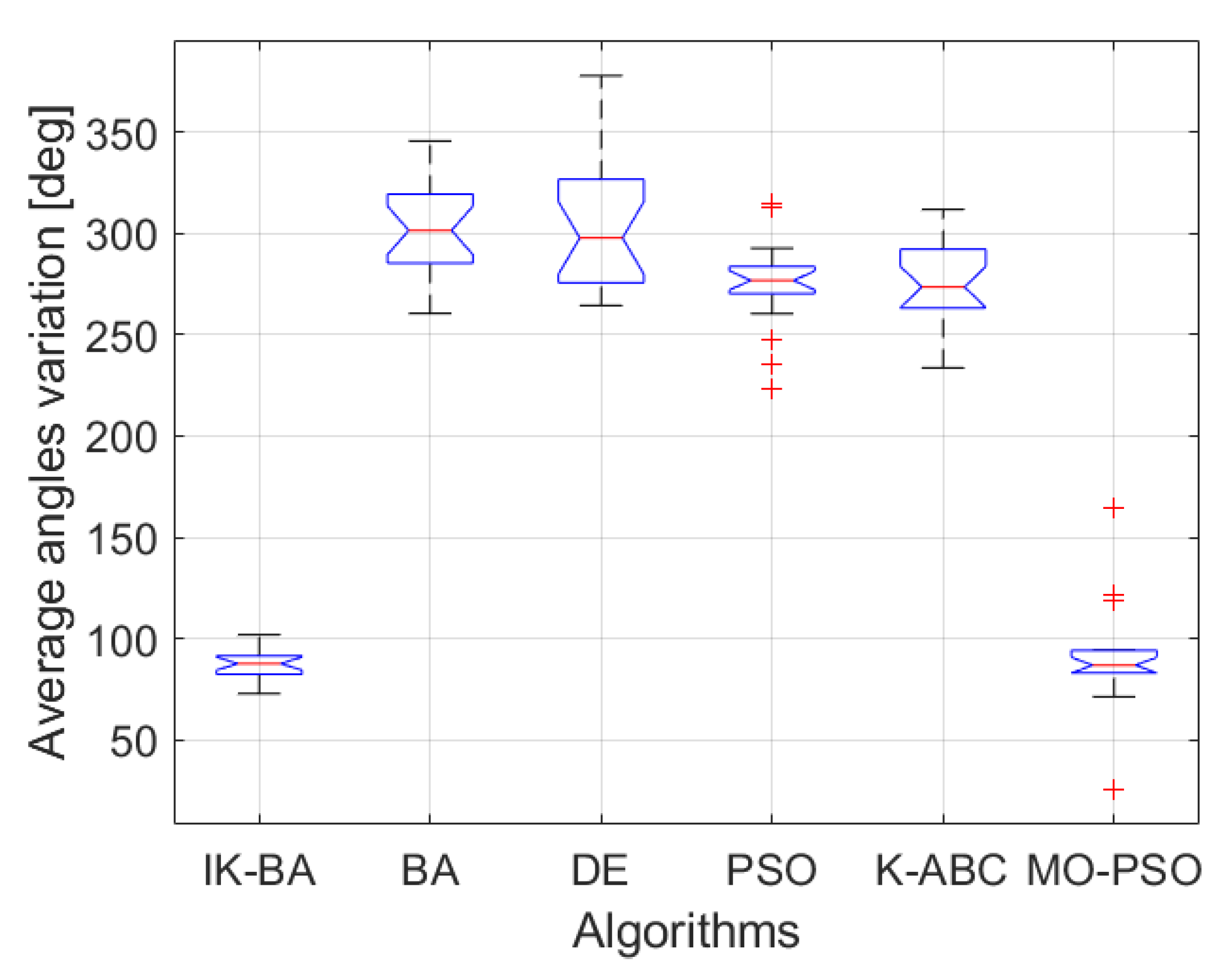
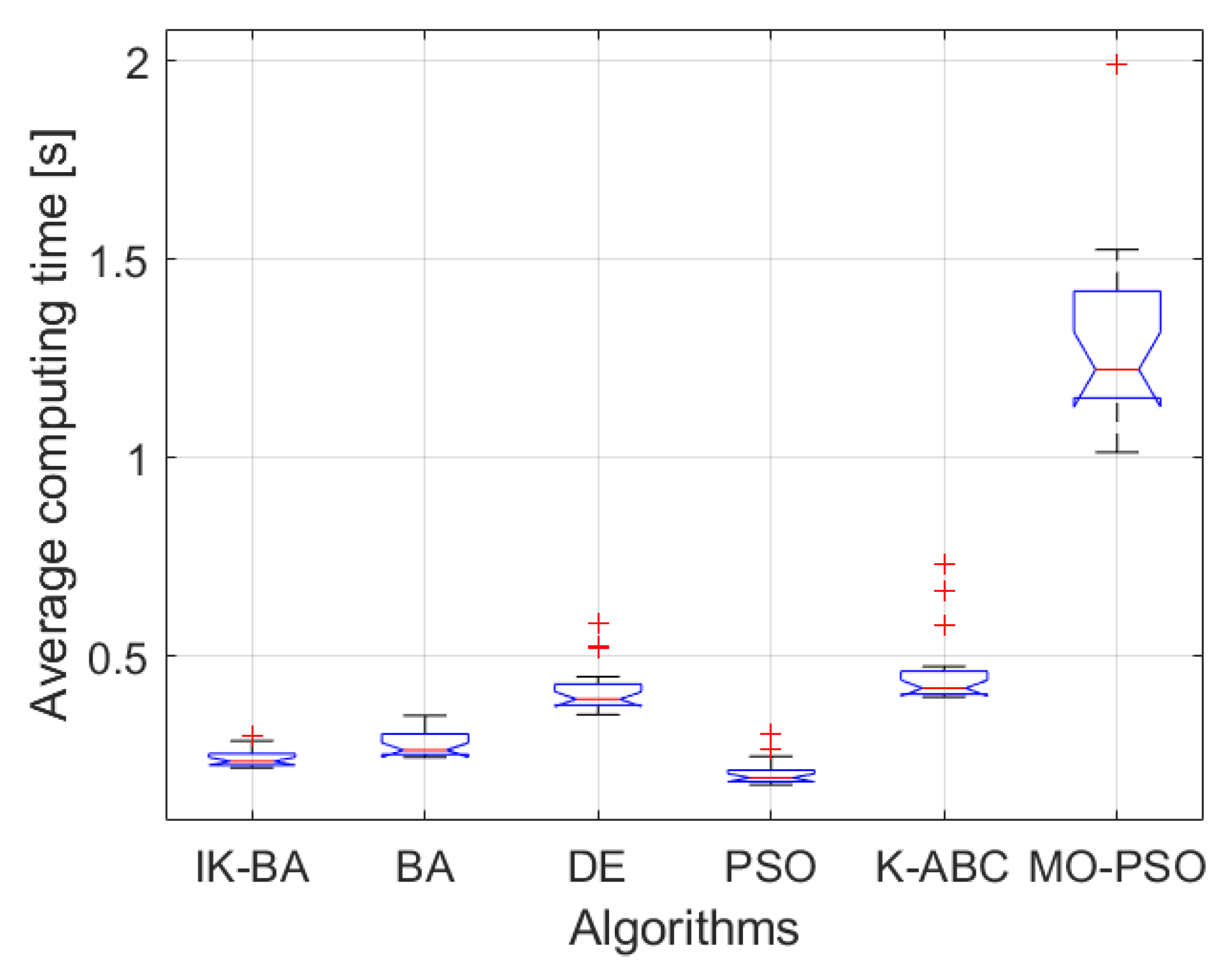
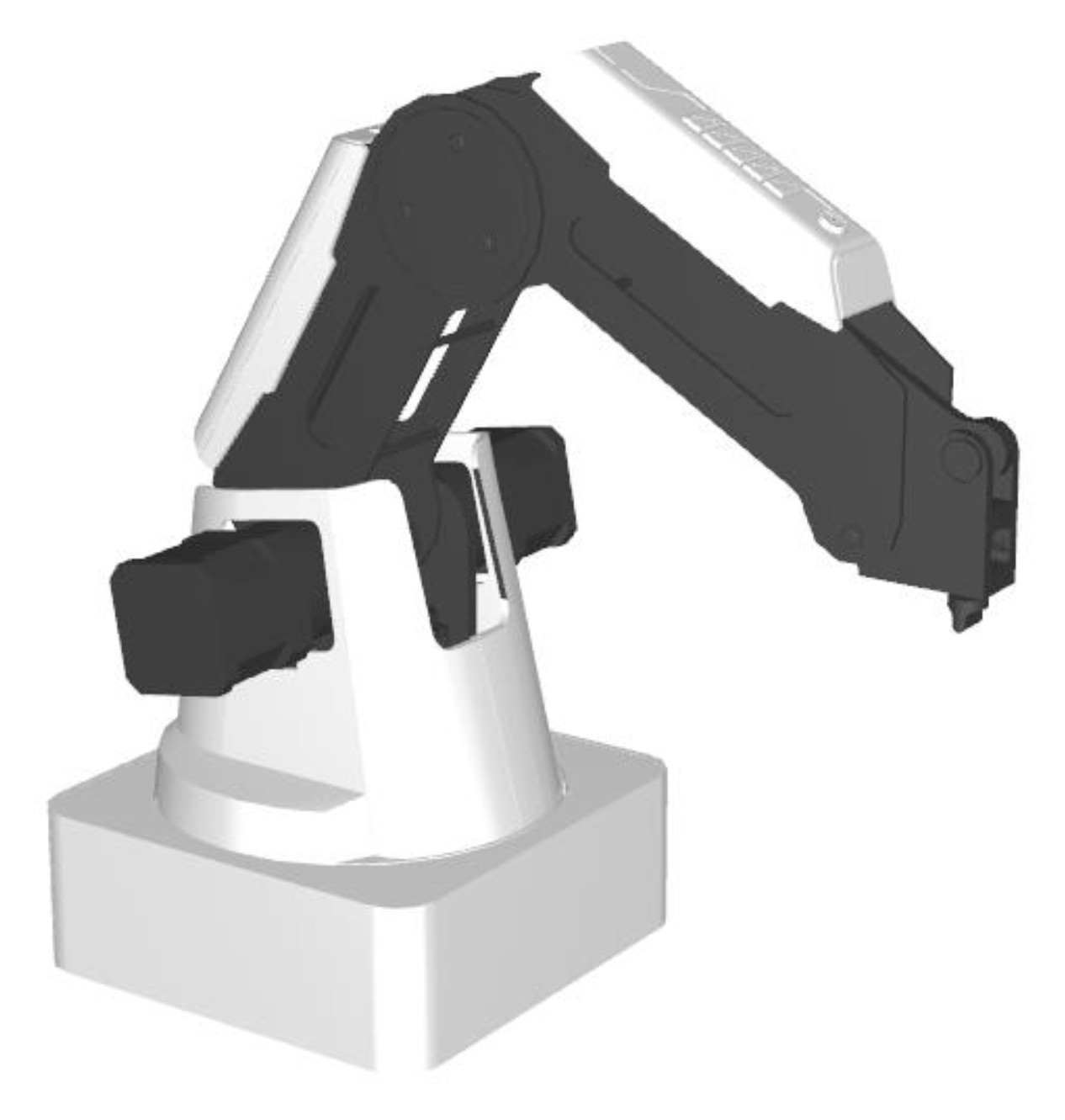

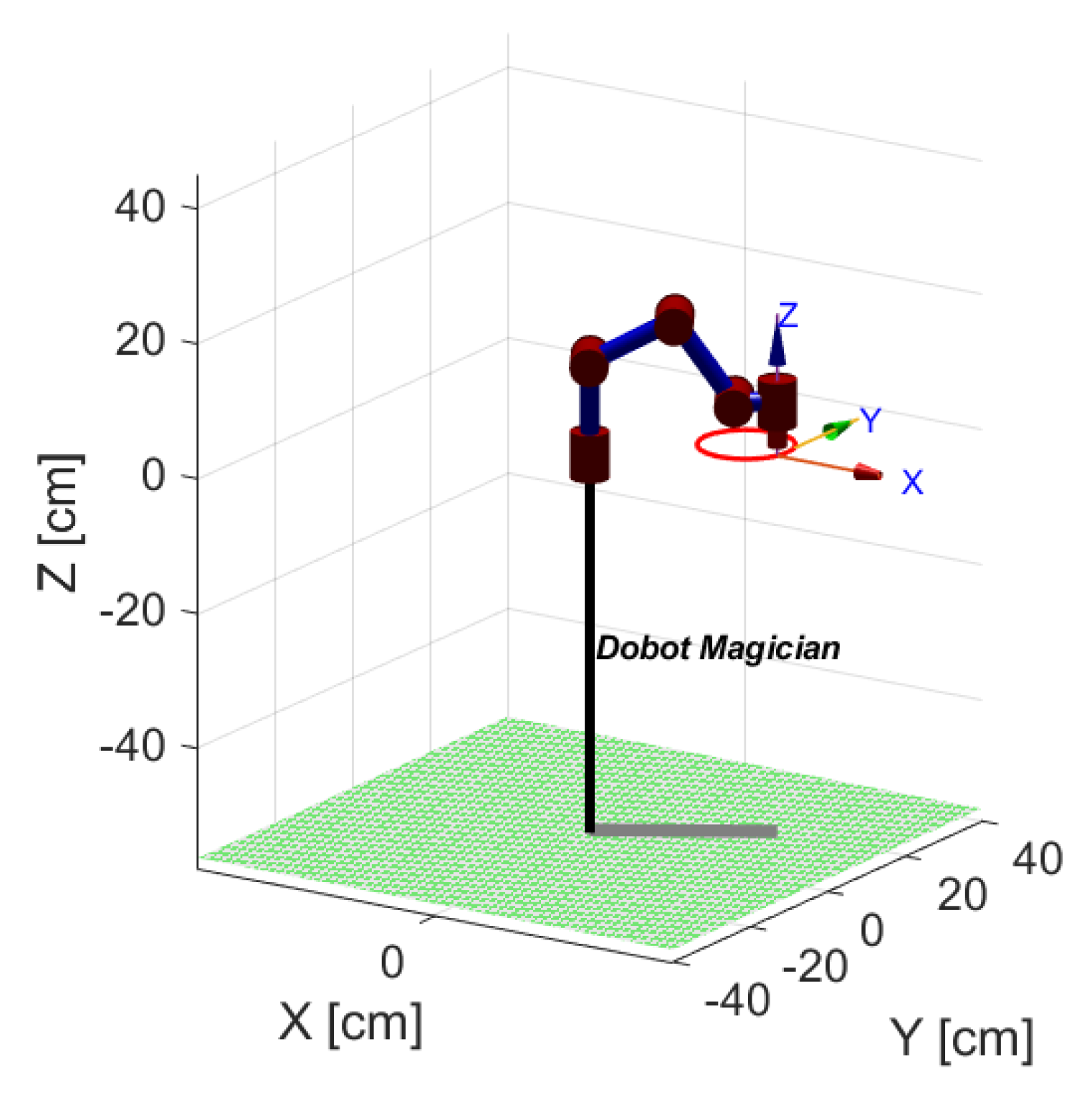

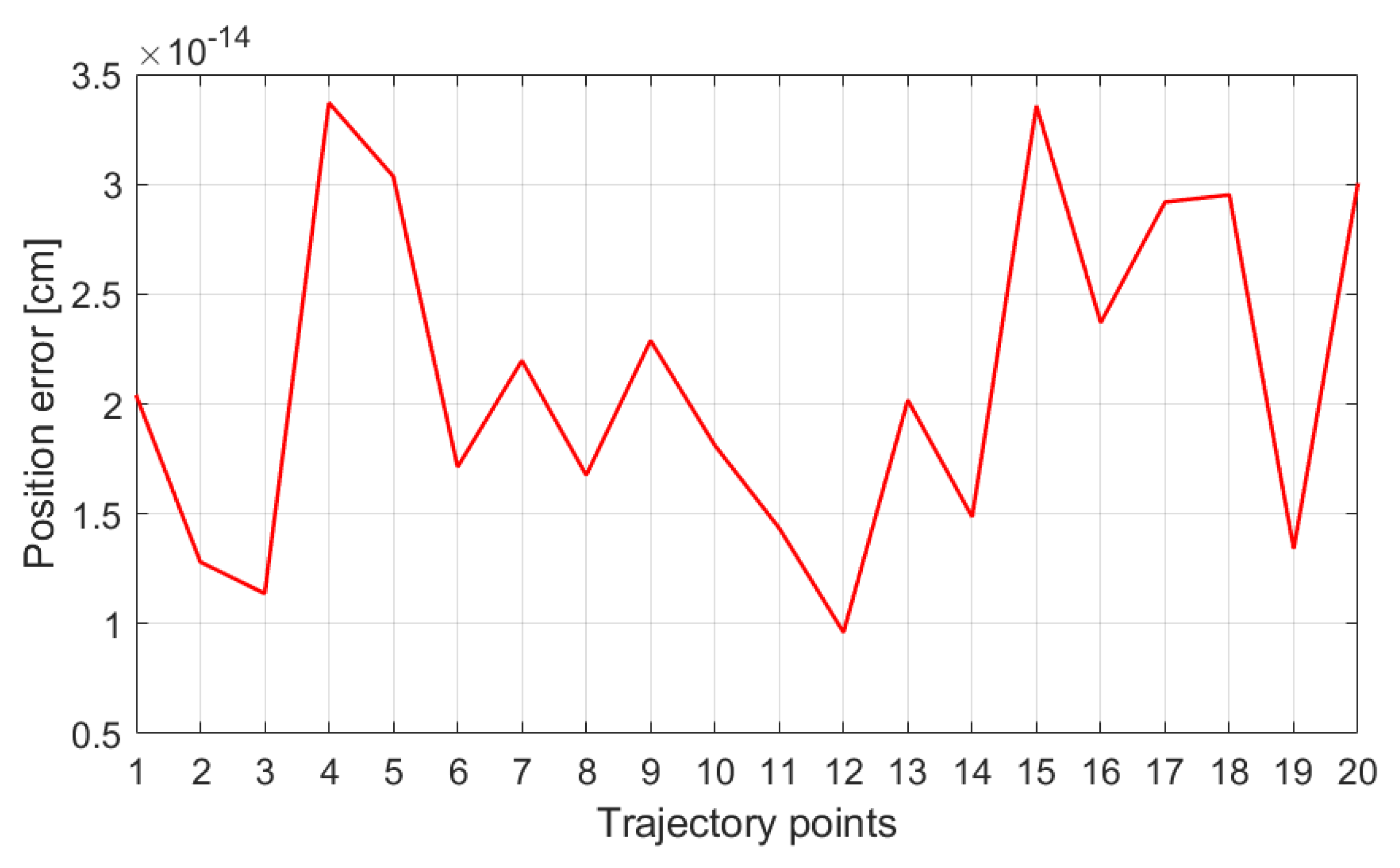
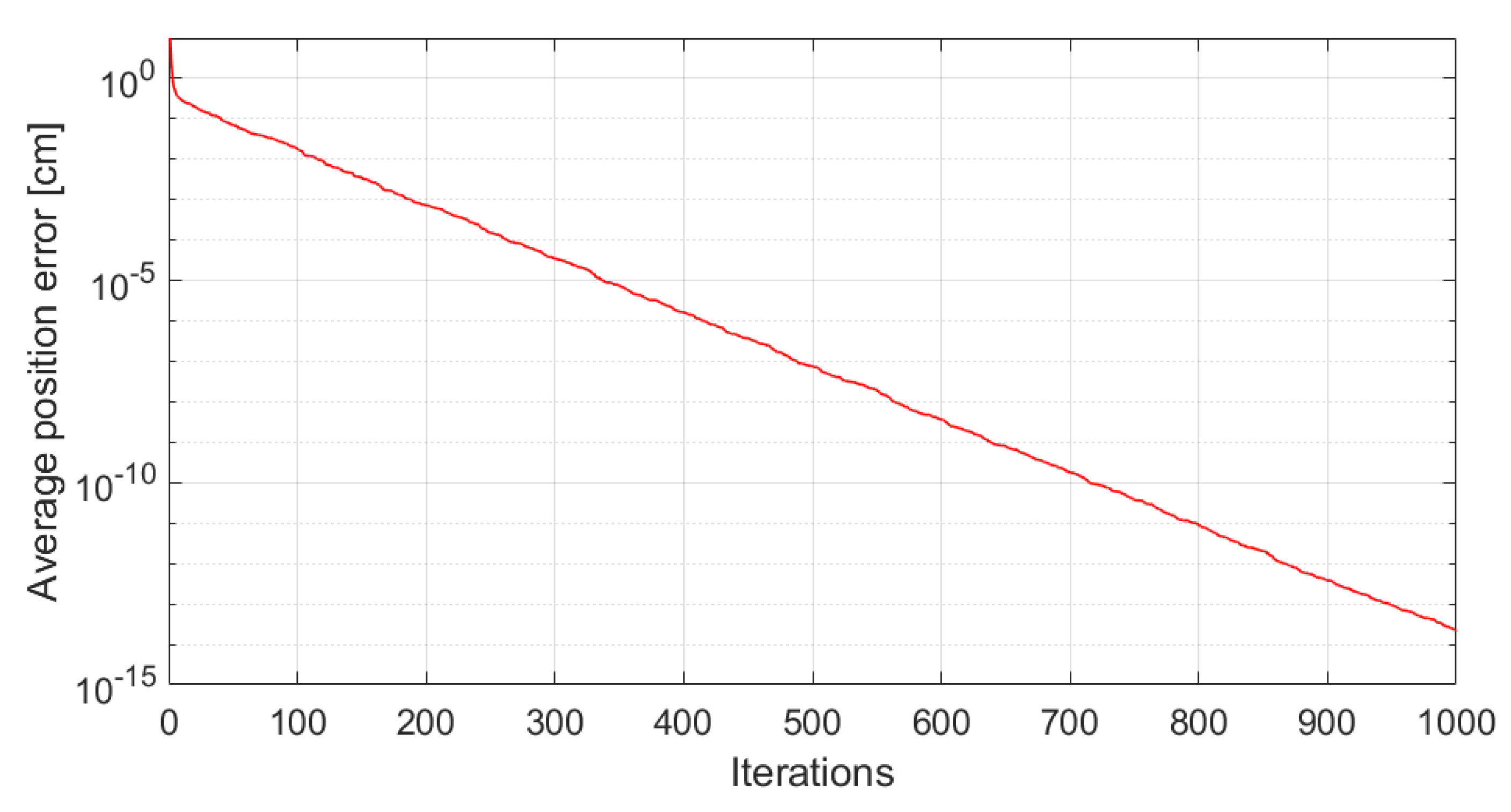
| Algorithm | Parameters | Values |
|---|---|---|
| IK-BA | Frequency range | [0, 2] |
| Increasing coefficient | 0.97 | |
| Attenuation coefficient () | 0.1 | |
| Loudness for each bat () | 1 | |
| Initial pulse rate () | 1 | |
| BA [48] | Frequency range | [0, 2] |
| Increasing coefficient | 0.5 | |
| Attenuation coefficient () | 0.5 | |
| Loudness for each bat () | Random number in the range of [0, 1] | |
| Initial pulse rate () | 0.001 | |
| DE [45] | Scaling factor () | 0.6 |
| Cross-over factor () | 0.9 | |
| PSO [43] | Inertia weight () | 1.1312 |
| Individual confidence factor () | 2.0149 | |
| Swarm confidence factor () | 0.53514 | |
| K-ABC [38] | No intrinsic parameters | |
| MO-PSO [49] | Inertia weight () | 0.5 |
| Individual confidence factor () | 2 | |
| Swarm confidence factor () | 2 | |
| Number of grids in each dimension () | 20 | |
| Maximum velocity () | 5 | |
| Uniform mutation percentage () | 0.5 |
| Link | [deg] | Range [deg] | |||
|---|---|---|---|---|---|
| 1 | 0 | −90 | [−170, 170] | ||
| 2 | 0 | 0 | 90 | [−120, 120] | |
| 3 | 0 | 90 | [−170, 170] | ||
| 4 | 0 | 0 | −90 | [−120, 120] | |
| 5 | 0 | −90 | [−170, 170] | ||
| 6 | 0 | 0 | 90 | [−120, 120] | |
| 7 | 0 | 0 | [−175, 175] |
| Algorithm | Performance | Mean | Median | Std | Maximum | Minimum |
|---|---|---|---|---|---|---|
| IK-BA | Position error [cm] | 0.0019 | 0.0019 | 1.7824 × 10−4 | 0.0022 | 0.0016 |
| Angles variation [deg] | 87.1916 | 87.5779 | 7.8247 | 101.8740 | 72.8021 | |
| Computing time [s] | 0.2439 | 0.2359 | 0.0229 | 0.3022 | 0.2195 | |
| BA | Position error [cm] | 1.6849 | 1.5374 | 0.9069 | 3.9487 | 0.1830 |
| Angles variation [deg] | 301.5794 | 301.5530 | 25.2466 | 345.7477 | 260.4859 | |
| Computing time [s] | 0.2800 | 0.2642 | 0.0335 | 0.3511 | 0.2462 | |
| DE | Position error [cm] | 0.3653 | 0.2793 | 0.2929 | 0.9981 | 0.0387 |
| Angles variation [deg] | 303.6915 | 297.8383 | 32.8049 | 377.9527 | 264.5489 | |
| Computing time [s] | 0.4154 | 0.3924 | 0.0617 | 0.5850 | 0.3534 | |
| PSO | Position error [cm] | 0.4382 | 0.4019 | 0.3312 | 1.0384 | 0.0000 |
| Angles variation [deg] | 274.7692 | 276.8618 | 21.9459 | 314.8747 | 223.3415 | |
| Computing time [s] | 0.2069 | 0.1946 | 0.0336 | 0.3029 | 0.1769 | |
| K-ABC | Position error [cm] | 0.2318 | 0.2232 | 0.0722 | 0.3515 | 0.1270 |
| Angles variation [deg] | 276.6456 | 273.5645 | 20.9967 | 311.8878 | 233.6387 | |
| Computing time [s] | 0.4591 | 0.4200 | 0.0926 | 0.7318 | 0.3980 | |
| MO-PSO | Position error [cm] | 0.4075 | 0.3960 | 0.0891 | 0.7014 | 0.2871 |
| Angles variation [deg] | 89.9602 | 86.8036 | 25.6630 | 164.1794 | 25.7217 | |
| Computing time [s] | 1.2853 | 1.2222 | 0.2282 | 1.9888 | 1.0135 |
| Source | SS | df | MS | F | Prob > F |
|---|---|---|---|---|---|
| Algorithms | 35.0338 | 5 | 7.0068 | 40.7685 | 7.2225 × 10−24 |
| Error | 19.5929 | 114 | 0.1719 | ||
| Total | 54.6267 | 119 |
| Source | SS | df | MS | F | Prob > F |
|---|---|---|---|---|---|
| Algorithms | 1.0877 × 106 | 5 | 2.1754 × 105 | 388.9396 | 7.1885 × 10−70 |
| Error | 6.3761 × 104 | 114 | 559.3091 | ||
| Total | 1.1514 × 106 | 119 |
| Source | SS | df | MS | F | Prob > F |
|---|---|---|---|---|---|
| Algorithms | 16.4700 | 5 | 3.2940 | 293.9766 | 2.1670 × 10−63 |
| Error | 1.2774 | 114 | 0.0112 | ||
| Total | 17.7474 | 119 |
| Number of Bats | Mean Time in ms | Median | Std | Maximum | Minimum |
|---|---|---|---|---|---|
| 12 | 48.01 | 45.8 | 10.1 | 67.2 | 32.6 |
| 15 | 61.09 | 64.10 | 12.85 | 92.35 | 41.81 |
| 20 | 83.75 | 73.03 | 28.96 | 80.06 | 47.88 |
| 30 | 180,94 | 101.29 | 149.67 | 448.44 | 69.52 |
| Trajectory Points | Joint Angles [deg] | Position Error [cm] | |||
|---|---|---|---|---|---|
| 1 | 34.8 | 66.5 | 49.5 | 34.8 | 2.04 × 10−14 |
| 2 | 38.7 | 69.6 | 45.6 | 38.7 | 1.28 × 10−14 |
| 3 | 42.9 | 71.4 | 43.5 | 42.9 | 1.14 × 10−14 |
| 4 | 47.1 | 71.4 | 43.5 | 47.1 | 3.37 × 10−14 |
| 5 | 51.3 | 69.6 | 45.6 | 51.3 | 3.04 × 10−14 |
| 6 | 55.2 | 66.5 | 49.5 | 55.2 | 1.71 × 10−14 |
| 7 | 58.6 | 62.6 | 54.8 | 58.6 | 2.20 × 10−14 |
| 8 | 61.2 | 58.4 | 61.1 | 61.2 | 1.68 × 10−14 |
| 9 | 62.8 | 54.6 | 68.0 | 62.8 | 2.29 × 10−14 |
| 10 | 62.8 | 51.5 | 75.2 | 62.8 | 1.81 × 10−14 |
| 11 | 60.6 | 49.5 | 82.2 | 60.6 | 1.43 × 10−14 |
| 12 | 56.0 | 48.8 | 88.3 | 56.0 | 9.61 × 10−14 |
| 13 | 49.0 | 48.8 | 92.0 | 49.0 | 2.02 × 10−14 |
| 14 | 41.0 | 48.8 | 92.0 | 41.0 | 1.49 × 10−14 |
| 15 | 34.0 | 48.8 | 88.3 | 34.0 | 3.36 × 10−14 |
| 16 | 29.4 | 49.5 | 82.2 | 29.4 | 2.37 × 10−14 |
| 17 | 27.2 | 51.5 | 75.2 | 27.2 | 2.92 × 10−14 |
| 18 | 27.2 | 54.6 | 68.0 | 27.2 | 2.95 × 10−14 |
| 19 | 28.8 | 58.4 | 61.1 | 28.8 | 1.34 × 10−14 |
| 20 | 31.4 | 62.6 | 54.8 | 31.4 | 3.00 × 10−14 |
Disclaimer/Publisher’s Note: The statements, opinions and data contained in all publications are solely those of the individual author(s) and contributor(s) and not of MDPI and/or the editor(s). MDPI and/or the editor(s) disclaim responsibility for any injury to people or property resulting from any ideas, methods, instructions or products referred to in the content. |
© 2023 by the authors. Licensee MDPI, Basel, Switzerland. This article is an open access article distributed under the terms and conditions of the Creative Commons Attribution (CC BY) license (https://creativecommons.org/licenses/by/4.0/).
Share and Cite
Slim, M.; Rokbani, N.; Neji, B.; Terres, M.A.; Beyrouthy, T. Inverse Kinematic Solver Based on Bat Algorithm for Robotic Arm Path Planning. Robotics 2023, 12, 38. https://doi.org/10.3390/robotics12020038
Slim M, Rokbani N, Neji B, Terres MA, Beyrouthy T. Inverse Kinematic Solver Based on Bat Algorithm for Robotic Arm Path Planning. Robotics. 2023; 12(2):38. https://doi.org/10.3390/robotics12020038
Chicago/Turabian StyleSlim, Mohamed, Nizar Rokbani, Bilel Neji, Mohamed Ali Terres, and Taha Beyrouthy. 2023. "Inverse Kinematic Solver Based on Bat Algorithm for Robotic Arm Path Planning" Robotics 12, no. 2: 38. https://doi.org/10.3390/robotics12020038
APA StyleSlim, M., Rokbani, N., Neji, B., Terres, M. A., & Beyrouthy, T. (2023). Inverse Kinematic Solver Based on Bat Algorithm for Robotic Arm Path Planning. Robotics, 12(2), 38. https://doi.org/10.3390/robotics12020038








